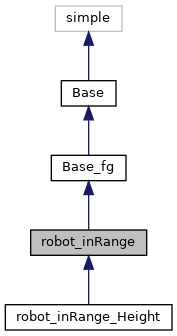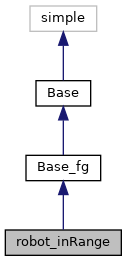Inheritance diagram for robot_inRange:

Collaboration diagram for robot_inRange:

Public Member Functions | |
| def | __init__ (self, low_th, high_th, tracker=None, trackFilter=None, Params params=Params()) |
| def | det_mask (self) |
 Public Member Functions inherited from Base_fg Public Member Functions inherited from Base_fg | |
| def | __init__ (self, theDetector, theTracker, trackFilter, Params params) |
 Public Member Functions inherited from Base Public Member Functions inherited from Base | |
| def | __init__ (self, theDetector, theTracker, trackFilter, Params params) |
| def | draw_layer (self, img=None, raw_detect=False, ax=None) |
| def | get_mask (self) |
| def | get_state (self) |
| def | measure (self, I) |
| def | update_params (self, name, val) |
Additional Inherited Members | |
 Public Attributes inherited from Base Public Attributes inherited from Base | |
| layer_mask | |
| layer_mask_det | |
| layer_state | |
| params | |
Constructor & Destructor Documentation
◆ __init__()
| def __init__ | ( | self, | |
| low_th, | |||
| high_th, | |||
tracker = None, |
|||
trackFilter = None, |
|||
| Params | params = Params() |
||
| ) |
The inRange robot segmenter detects the segmenter with the assumption that the depth of the robot falls within a certain range. @param[in] low_th float.The lower threshold for the inRange method @param[in] high_th float.The higher threshold for teh inRange method
Member Function Documentation
◆ det_mask()
| def det_mask | ( | self | ) |
Get the detection mask. Based on the ivapylib/detector/testing/*_inRange.py, the in-range is constructed using the base class inImage, and the mask is get from self.Ip TODO: seems a little weird to me. I think there should be a generic get mask method
Reimplemented from Base_fg.
The documentation for this class was generated from the following file:
- /local/source/python/Surveillance/Surveillance/layers/robot_seg.py